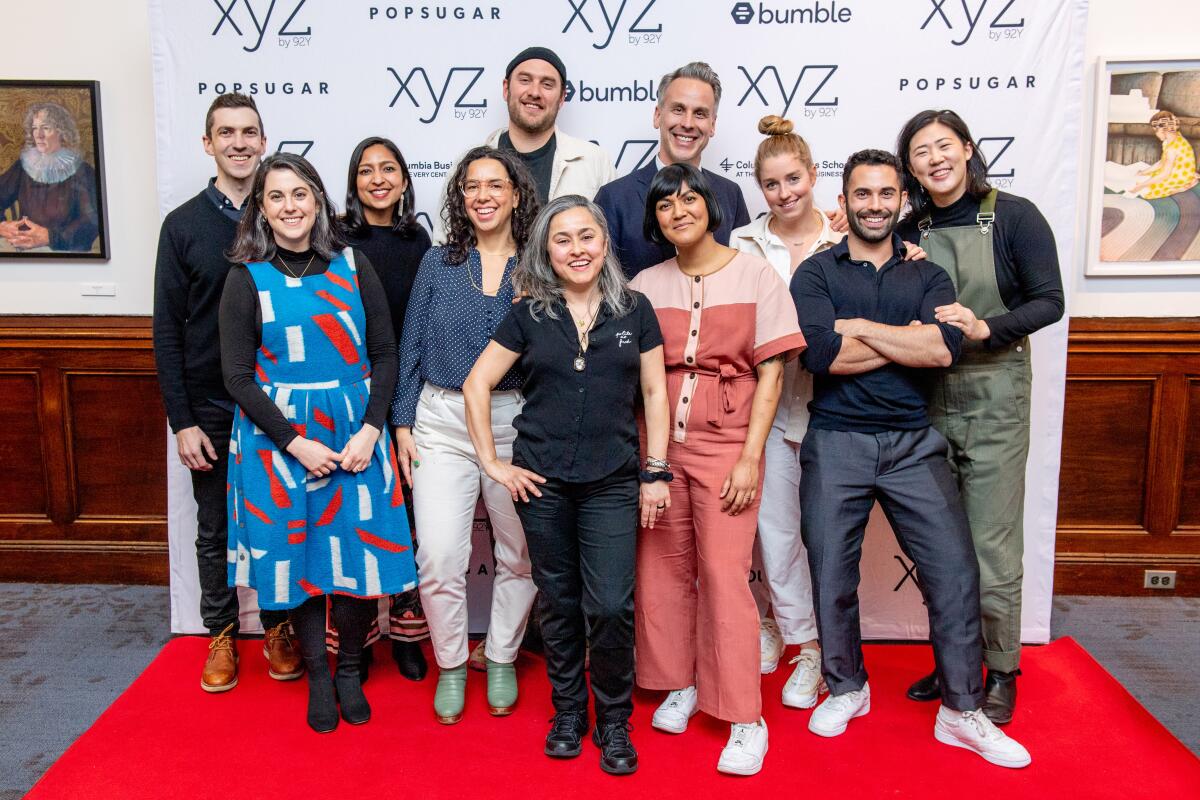Bon Appétit, American food media and the need for change

- Share via
“What is happening at Bon Appétit?” a barrage of friends texted this past week. A lot of them weren’t “food people,” but they knew the 64-year-old magazine’s brand. Social media was ablaze with the news of editor-in-chief Adam Rapoport’s resignation.
The bonfire started when Illyanna Maisonet, who has written a column about Puerto Rican cooking culture for the San Francisco Chronicle, posted an Instagram direct-message thread with Rapoport from last weekend; they had discussed why previous pitches for stories focused on Puerto Rican food had been rejected by a Bon Appétit editor. Then on Monday, Brooklyn-based food and drinks writer Tammie Teclemariam posted on Twitter a 2004 photo of Rapoport and his wife, Simone Shubuck, in Halloween costumes that perpetuated stereotypes of Puerto Ricans.
Eat your way across L.A.
Get our weekly Tasting Notes newsletter for reviews, news and more.
You may occasionally receive promotional content from the Los Angeles Times.
Rapoport resigned Monday afternoon, apologizing in an Instagram statement (the account has since been deleted). In the midst of it, Bon Appétit staffers began speaking out about the systemic racism they experienced in the magazine’s work culture. Two days later Matt Duckor, a vice president of programming with Condé Nast whose responsibilities included oversight of Bon Appetit’s 6-million-subscriber-strong YouTube video presence, left the media company. Decade-old tweets in which Duckor mentions Blacks, Asians, gay men and same-sex couples in casual jest came to light. An online petition with more than 5,000 signatures described Duckor as “the architect of a predatory and discriminatory system that paid white editors at Bon Appétit for their video work, while their nonwhite editors received nothing.”
The outsize show of support for Bon App staffers and the speed of these departures is without question tied to the protests sparked by the recent killings of George Floyd, Breonna Taylor, Ahmaud Arbery, David McAtee and Tony McDade. The age of digital imagery — screenshots of offensive photos, cellphone videos of police brutality — helped usher in an American cultural reckoning that is painfully overdue.
Innate forms of oppression in the larger culture play out in the microcosm of white-centric media.

Amanda Shapiro, who was leading Condé Nast’s Healthyish platform, is now acting deputy director of Bon Appétit, according to the New York Times. Shapiro, who is white, told the NYT that she “pressed for a person of color to be named as the new editor-in-chief.”
Soleil Ho, restaurant critic for the San Francisco Chronicle, reacted in a piece where she voiced concern that naming a new BIPOC editor-in-chief without more profound structural change could be an egregious error. “The worst-case scenario is bringing in a minority leader who is blackballed by the intricate and expansive checks of the institution and then blamed when things either don’t change or fall apart,” she wrote. “Whatever expansive ideas she might have for reform could be quashed easily by the same set of excuses: concerns for alienating subscribers, lowering house standards or putting resources into work that may not garner enough clicks.”
It brings to mind the “glass cliff,” the idea that women (and people of color) are brought into top-level positions only when companies are faltering. Often, if they fail in these roles, they are given fewer opportunities afterward than their male, white counterparts.
In the two weeks since the protests began, this is what I’ve heard most clearly from Black food writers: They are exhausted. They are tired of being the fighters, the sermonizers, the educators, the underpaid. Their burden must now be the burden of white and nonwhite allies, full stop.
This affliction is long-running and yet rarely grasped. It took a confluence of events during a pandemic for millions of us to finally start to acknowledge the underlying symptoms of America’s sickness around racism.
Enjoying this newsletter? Consider subscribing to the Los Angeles Times
Your support helps us deliver the news that matters most. Become a subscriber.
In 2018 Nikita Richardson wrote an article for Grub Street titled “Where Are All the Black Restaurant Critics?” The prompt for the piece was an unprecedented sweep of awards for Black chefs at the year’s James Beard Foundation awards; Edouardo Jordan, chef-owner of Solare and JuneBaby in Seattle, and Dolester Miles, pastry chef of Highlands Bar and Grill in Birmingham, Ala., were among the winners.
Where, though, were the Black arbiters and reviewers to help shape the championing and enlighten diners and readers about overlooked chefs and future stars? The accolades (including Michael W. Twitty’s nod that year for his enlightening memoir “The Cooking Gene”) highlighted for Richardson “just how rare an occurrence this kind of acclaim is for Black chefs, writers and journalists, and how performative it can feel when white-led institutions make a point to champion certain African Americans while ignoring others.”
The answer to the question in her headline remains “none.” To my knowledge there are no Black journalists regularly employed as restaurant critics in America. Food criticism is a dying profession; I made a list earlier this year, before COVID-19, and counted fewer than 50 working food critics in America. It is no excuse. We need Black critics.
Even in this moment, it remains my job to report on the pluralism of Los Angeles. Black-owned and -led restaurants have been part of the mix since Patricia Escárcega and I began as critics in December 2018. Can I cover them more meaningfully, think harder, push back my own and others’ assumptions? Absolutely. The deeper work is: Where have I brought implicit bias and skewered notions of excellence into my writing? Too few of my colleagues at the Los Angeles Times are Black, an actuality that has to change. I expect my colleagues and editors at the paper to talk more frankly about what’s patronizing, performative and tokenistic — and what is journalism for the greater good.
We have the most diverse Food section staff in The Times’ history. The ending of Richardson’s piece sticks in my brain, though. She quotes Shakirah Simley, an activist and writer in San Francisco. “I don’t really care about diversity,” Simley says in the article. “I care about equity and I care about justice. Those are two very, very different things … not just having folks of color at the table but putting them at the head of the table and having their voices be the ones that are leading.”
Check out Samin Nosrat’s Instagram feed of Black chefs and writers to follow. Subscribe to Whetstone, a quarterly publication I love about indigenous foodways (and the only Black-owned food magazine in America) and the forthcoming magazine For the Culture. Read my colleagues LZ Granderson, Erika D. Smith and Erin B. Logan, for starters. Pore over Osayi Endolyn’s piercing, vital essay “Trapped in While Dining Out,” and then buy the book, called “Women on Food,” in which the full version was published.
These suggestions echo frequent recommendations many have made during the last two weeks. They are a start. This is only a start.
Have a question for the critics?
Our stories
— Jonathan Kauffman reports on how the Bay Area has become the center of a robotic food revolution via high-tech vending machines: Think robot baristas, salad machines, hot ramen on demand and fresh-baked croissants.
— Jenn Harris takes us to the front lines of downtown’s Faith & Flower, on the night its dining room reopened for service. (After Jenn did her reporting, one of the restaurant’s owners, Stephane Bombet, exited the business after photos of him in blackface surfaced.)
— A Santa Barbara restaurant dropped a name that many considered racist.
— Shashank Bengali writes about how one of Thailand’s craft brewers denounces the country’s restrictive alcohol laws, brewing a fight and creating a sensation.
— In case you missed it, Patricia Escárcega featured 16-year-old Oakland chef Rahanna Bisseret Martinez, and her thoughts on how food media can change, in last week’s newsletter.

Eat your way across L.A.
Get our weekly Tasting Notes newsletter for reviews, news and more.
You may occasionally receive promotional content from the Los Angeles Times.




